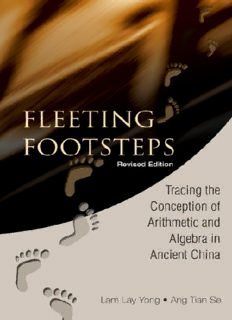
Fleeting Footsteps: Tracing the Conception of Arithmetic and Algebra in Ancient China, Revised Edition PDF
Preview Fleeting Footsteps: Tracing the Conception of Arithmetic and Algebra in Ancient China, Revised Edition
5425.tp 1/27/04 8:50 AM Page 1 FLEETING FOOTSTEPS Revised Edition 5425.tp 1/27/04 8:50 AM Page 2 FLEETING FOOTSTEPS Revised Edition Tracing the Conception of Arithmetic and Algebra in Ancient China Lam Lay Yong Ang Tian Se W World Scientific NEW JERSEY • LONDON • SINGAPORE • SHANGHAI • HONG KONG • TAIPEI • CHENNAI This page intentionally left blank Published by World Scientific Publishing Co. Pte. Ltd. 5 Toh Tuck Link, Singapore 596224 USA office: 27 Warren Street, Suite 401-402, Hackensack, NJ 07601 UK office: 57 Shelton Street, Covent Garden, London WC2H 9HE British Library Cataloguing-in-Publication Data A catalogue record for this book is available from the British Library. FLEETING FOOTSTEPS (Revised Edition) Tracing the Conception of Arithmetic and Algebra in Ancient China Copyright © 2004 by World Scientific Publishing Co. Pte. Ltd. All rights reserved. This book, or parts thereof, may not be reproduced in any form or by any means, electronic or mechanical, including photocopying, recording or any information storage and retrieval system now known or to be invented, without written permission from the Publisher. For photocopying of material in this volume, please pay a copying fee through the Copyright Clearance Center, Inc., 222 Rosewood Drive, Danvers, MA 01923, USA. In this case permission to photocopy is not required from the publisher. ISBN 981-238-696-3 Printed in Singapore. To the scholars known and unknown, whose footsteps east to west, have brought about this book. v FF-delication.p65 5 11/5/03, 11:57 AM This page intentionally left blank Contents Foreword xi Preface xvii Introduction xix Ancient Chinese Mathematics and Its Influence on World Mathematics 1 PART ONE 1 The Sun Zi Suanjing (The Mathematical Classic of Sun Zi) 25 1.1 The text in perspective 25 1.2 Author and date 26 1.3 Existing versions 28 1.4 The translation 32 2 Numbers and Numerals 33 2.1 Why the need for a detailed study of numbers and numerals? 33 vii contents.p65 7 1/9/04, 11:31 AM viii Fleeting Footsteps 2.2 The written numbers 34 2.2.1 Structure and concept 34 2.2.2 Number word and number symbol are identical 37 2.2.3 Numerical ranks are indicated 37 2.2.4 Large numbers 38 2.2.5 Summary 42 2.2.6 On the translation of numbers in Sun Zi suanjing 42 2.3 The rod numerals 43 2.3.1 Description 43 2.3.2 Historical background 44 2.3.3 The intrinsic properties 48 2.3.4 Summary 50 3 The Fundamental Operations of Arithmetic 53 3.1 Were the operations simple? 53 3.2 Manipulating rod digits 54 3.3 Multiplication 56 3.3.1 The method in Sun Zi suanjing 56 3.3.2 The Chinese method and the earliest method in Islam 60 3.4 Division 63 3.4.1 The method in Sun Zi suanjing 63 3.4.2 The earliest method in Islam 68 3.5 Addition and subtraction 71 3.6 The multiplication table 73 3.7 Conclusion 77 4 The Common Fraction 79 4.1 Concept, notation and rules 79 4.2 The reduction of a fraction 81 4.3 The addition and subtraction of fractions 83 4.4 The averaging of fractions 85 4.5 Other rules 88 4.6 The subject in general 90 5 On Extracting Roots of Numbers 93 5.1 The background 93 5.2 The method in Sun Zi suanjing 94 contents.p65 8 1/9/04, 11:31 AM Contents ix 5.3 An analysis of the method 103 5.3.1 A comparison with the method of division 103 5.3.2 An approximation for an irrational root 105 5.3.3 The geometrical derivation and its arithmetization 107 5.4 Significance of the method 110 5.5 Conclusion 112 6 Tables of Measures 113 6.1 Introduction 113 6.2 Measures of length 114 6.3 Measures of weight 117 6.4 Measures of capacity 117 6.5 A common set of decimal fractional units 118 6.6 Densities 118 7 The Various Problems 121 7.1 The problems in Sun Zi suanjing 121 7.2 Rule of Three 122 7.3 Geometrical configurations 126 7.3.1 Length 126 7.3.2 Square and rectangle 126 7.3.3 Circle and spherical segment 128 7.3.4 Volume 128 7.4 Partnership and sharing 129 7.5 The remainder problem 138 7.6 Rule of False Position 140 7.7 Fang cheng method 145 7.8 Miscellaneous problems 154 7.9 Listing the early mathematical methods 160 8 Socioeconomic Aspects in Sun Zi’s China 163 8.1 The period 163 8.2 Buddhism 164 8.3 Wei qi and the nobility 164 8.4 Taxation 165 8.5 The barter trade 167 contents.p65 9 1/9/04, 11:31 AM
Description: